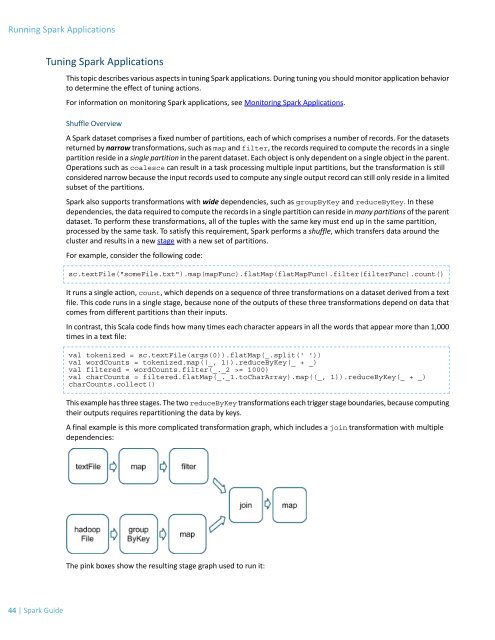cloudera-spark
Create successful ePaper yourself
Turn your PDF publications into a flip-book with our unique Google optimized e-Paper software.
Running Spark Applications<br />
Tuning Spark Applications<br />
This topic describes various aspects in tuning Spark applications. During tuning you should monitor application behavior<br />
to determine the effect of tuning actions.<br />
For information on monitoring Spark applications, see Monitoring Spark Applications.<br />
Shuffle Overview<br />
A Spark dataset comprises a fixed number of partitions, each of which comprises a number of records. For the datasets<br />
returned by narrow transformations, such as map and filter, the records required to compute the records in a single<br />
partition reside in a single partition in the parent dataset. Each object is only dependent on a single object in the parent.<br />
Operations such as coalesce can result in a task processing multiple input partitions, but the transformation is still<br />
considered narrow because the input records used to compute any single output record can still only reside in a limited<br />
subset of the partitions.<br />
Spark also supports transformations with wide dependencies, such as groupByKey and reduceByKey. In these<br />
dependencies, the data required to compute the records in a single partition can reside in many partitions of the parent<br />
dataset. To perform these transformations, all of the tuples with the same key must end up in the same partition,<br />
processed by the same task. To satisfy this requirement, Spark performs a shuffle, which transfers data around the<br />
cluster and results in a new stage with a new set of partitions.<br />
For example, consider the following code:<br />
sc.textFile("someFile.txt").map(mapFunc).flatMap(flatMapFunc).filter(filterFunc).count()<br />
It runs a single action, count, which depends on a sequence of three transformations on a dataset derived from a text<br />
file. This code runs in a single stage, because none of the outputs of these three transformations depend on data that<br />
comes from different partitions than their inputs.<br />
In contrast, this Scala code finds how many times each character appears in all the words that appear more than 1,000<br />
times in a text file:<br />
val tokenized = sc.textFile(args(0)).flatMap(_.split(' '))<br />
val wordCounts = tokenized.map((_, 1)).reduceByKey(_ + _)<br />
val filtered = wordCounts.filter(_._2 >= 1000)<br />
val charCounts = filtered.flatMap(_._1.toCharArray).map((_, 1)).reduceByKey(_ + _)<br />
charCounts.collect()<br />
This example has three stages. The two reduceByKey transformations each trigger stage boundaries, because computing<br />
their outputs requires repartitioning the data by keys.<br />
A final example is this more complicated transformation graph, which includes a join transformation with multiple<br />
dependencies:<br />
The pink boxes show the resulting stage graph used to run it:<br />
44 | Spark Guide




